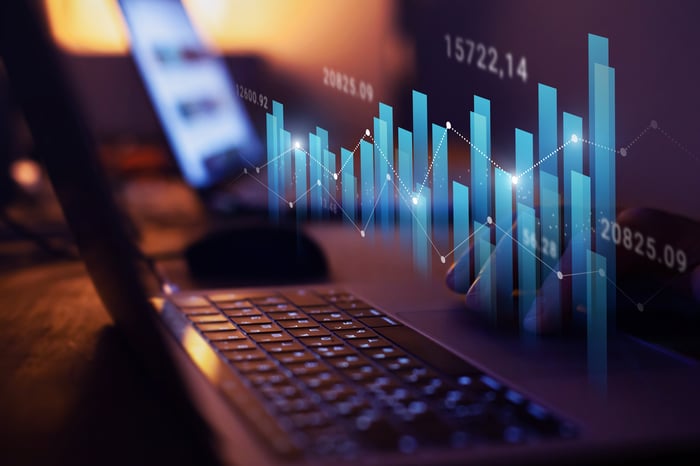[ad_1]
This household name could be the next big beneficiary of AI.
Artificial intelligence (AI) went viral early last year, and arguably, no company has benefited more than Nvidia (NVDA 0.34%). The company’s graphics processing units (GPUs) have become the go-to for powering generative AI. Thanks to five consecutive quarters of triple-digit revenue and profit growth, Nvidia stock has been on fire, up more than 900% (as of this writing) in less than two years. This has pushed the chipmaker’s market cap above $3.6 trillion, making it the world’s most valuable company.
However, there are those who believe that the growing specter of competition and a premium valuation make Nvidia stock a bit risky at this stage, and they’re looking for other ways to invest in the AI revolution. One underappreciated opportunity is Apple (AAPL 1.38%). The iPhone maker has taken a more measured approach to AI adoption and recently released its first flagship device powered by these sophisticated algorithms — and many believe the best is yet to come.
The company’s track record is indisputable. Apple stock has climbed 717% over the past decade, far outpacing the 193% gains of the S&P 500 (as of this writing). However, with its unique spin on AI, Apple could add to its impressive tally, reaching a market cap of $4 trillion over the coming year or so.

Image source: Getty Images.
Growth interrupted
Despite its place atop the smartphone heap, the past couple of years have been challenging for the house that iPhone built. Macroeconomic headwinds convinced many of the Apple faithful to hang onto their devices a bit longer, waiting for conditions to improve. As a result, sales slowed to a crawl, and some investors wondered its the iPhone makers best days were behind it. Taking a step back, however, provides critical context.
Despite an industrywide slowdown, Apple continued to gain share. The company boasted seven of the top 10 smartphones of 2023, according to data supplied by Counterpoint Research. With economic conditions improving and inflation fading, Apple fans are more likely to spring for the latest model.
Wedbush analyst Dan Ives calculates there are an estimated 300 million active iPhones that are at least four years old. With more breathing room in their budgets, it’s increasingly likely Apple customers will make the long-awaited decision to upgrade. Ives believes the recently released iPhone 16 will lead the way, helping Apple sell as many as 240 million iPhones over the coming year, sparking what the analyst dubs as an “AI-driven super cycle.”
Increased functionality
While the prospect of the getting their hands on the newest iPhone is enough for many Apple fans, others require greater incentive to take the plunge. The latest model may be the excuse many have been waiting for. The iPhone 16 includes more robust camera features, a more efficient processor, and improved battery life. The greatest potential, however, will come courtesy of Apple Intelligence, the company’s unique spin on AI functionality. The iPhone 16 lineup “harnesses the power of Apple silicon and Apple-built generative AI models” to take the device to the next level.
Not only can it create text and images from scratch, but it can also take action across a variety of apps, all while providing Apple’s signature focus on security. These tasks include:
- Writing, rewriting, and proofreading text in Mail, Notes, Pages, and third-party apps.
- Recording, transcribing, and summarizing audio, and providing key points of conversations.
- Prioritizing and summarizing notifications within Mail.
- Providing greater language understanding, powering a much-needed upgrade for Siri.
- Offering extensive product knowledge of Apple devices.
- Creating new emojis simply by providing a description
- Accessing OpenAI’s ChatGPT.
Apple promises this is just the beginning and plans to roll out additional Apple Intelligence features in the months and years to come.
The case for $4 trillion
To be clear, Apple will have to deliver on the promise of its latest iPhone, as the flagship device represented 51% of Apple’s total sales for the fiscal year ended Sep. 28.
Apple is expected to generate revenue of $414 billion in fiscal 2025, resulting in a forward price-to-sales (P/S) ratio of roughly 8.2. Assuming its P/S remains constant, Apple would need to grow its revenue to roughly $488 billion annually to support a $4 trillion market cap. Apple could easily reach this threshold by early 2027.
Ives believes Wall Street’s growth estimates are conservative. He believes — as I do — that Apple’s integration of AI into the iPhone will be the catalyst for the next stage of Apple’s growth. Ives calculates that the sale 240 million iPhones and the resulting ancillary sales of apps and other services will add as much as $30 to $40 to Apple’s share price, easily pushing the company’s market cap over $4 trillion during the coming 12 to 18 months.
With an estimated 1.4 billion iPhones in the wild, it will take just 17% of those users to upgrade to iPhone 16 to achieve 240 million device sales, so that number could well be conservative. Some investors have thrown Apple stock on the scrap heap, but I believe that could be a costly mistake.
Finally, the stock is currently selling for 30 times forward earnings, which is an attractive price for a company with Apple’s track record. If a super cycle for the iPhone materializes — and I suspect it’s only a matter of time — its market cap could hit $4 trillion sooner than later.
[ad_2]
Source link

